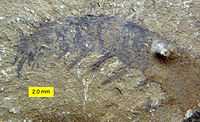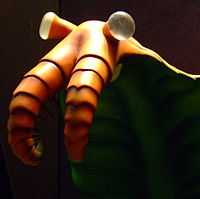Great appendage
Great appendage of Anomalocaris


Great appendages are large claw-like appendages which attach to the heads of the "great appendage arthropods", a group whose monophyly is debated, but which includes the anomalocaridids. The great appendages are used in food manipulation; Anomalocaris used them to manipulate prey such as trilobites,[1] while Laggania used them to filter algae and similar small particles from the water in which it dwelt. They are thought to be homologous with the antennule of the euarthropods,[2] or the chelicerae of chelicerates.[3]
Two types of great appendage are recognised; the first, the long great appendage such as that seen in the anomalocaridids, resembles a 15–unit leg; whereas the more ubiquitous short great appendage characteristic of the Megacheira is arm-like with a claw-like end. The latter form is a synapomorphy of the euarthopods and may be homologous with the large great appendage.[2]
References
- ↑ Christopher Nedin (1999). "Anomalocaris predation on nonmineralized and mineralized trilobites". Geology 27 (11): 987–990. Bibcode:1999Geo....27..987N. doi:10.1130/0091-7613(1999)027<0987:APONAM>2.3.CO;2.
- ↑ 2.0 2.1 Martin Stein (2010). "A new arthropod from the Early Cambrian of North Greenland, with a ‘great appendage’-like antennula". Zoological Journal of the Linnean Society 158 (3): 477–500. doi:10.1111/j.1096-3642.2009.00562.x.
- ↑ Stephen Dornbos, David Bottjer & Jun-Yuan Chen (2004). "Evidence for seafloor microbial mats and associated metazoan lifestyles in Lower Cambrian phosphorites of Southwest China" (PDF). Lethaia 37 (2): 127–137. doi:10.1080/00241160410004764.